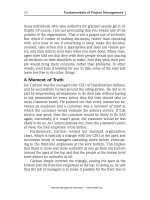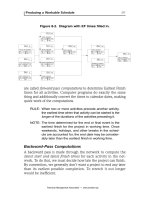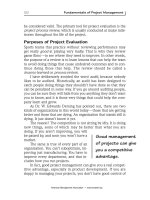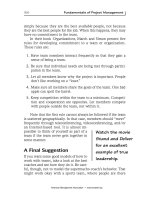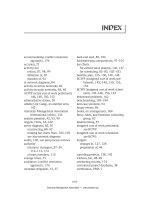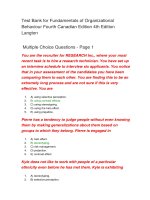Fundamentals of organizational behavior 2e by dubrin ch08
Bạn đang xem bản rút gọn của tài liệu. Xem và tải ngay bản đầy đủ của tài liệu tại đây (615.92 KB, 25 trang )
Interpersonal Communication
Chapter
8
Fundamentals of
Organizational Behavior 2e
Andrew J. DuBrin
PowerPoint Presentation
by Charlie Cook
Learning Objectives
1. Describe the communication process.
2. Describe the impact of information technology on
interpersonal communication in organizations.
3. Explain how nonverbal communication can be used to
enhance communication.
4. Present details about the various channels of
communication in organizations.
5. Summarize barriers to effective communication and
how to overcome them.
6. Explain how to overcome cross-gender and crosscultural communication problems.
7. Recognize the basics for becoming a more poweroriented communicator.
A. J. DuBrin, Fundamentals of Organizational
8–2
The Communication Process
Components of Communication
1. Source (the sender)—person attempting to send a message
to another person. Authority and experience of sender can
call attention to message.
2. Message—a purpose or idea to be conveyed. Clarity,
complexity, length, and organization affect reception of
message.
3. Channel (medium)—how and through what media the
message is conveyed to the receiver.
4. Receiver—the party to whom the message is sent must get
and understand properly the message for communication
to take place.
A. J. DuBrin, Fundamentals of Organizational
8–3
The Communication Process
Components of Communication (cont’d)
5. Feedback—reactions of the receiver that indicate the
message was received and properly understood.
6. Environment—factors such as organizational culture affect
how messages are transmitted and understood.
7. Noise—physical and human
relations distractions in the
environment can disrupt the
communication process.
A. J. DuBrin, Fundamentals of Organizational
8–4
The Communication Process
Environment
Source
(sender)
Channel
Message
Receiver
Environment
Environment
Noise Sources
Feedback
Noise Sources
EXHIBIT
8-1
Environment
A. J. DuBrin, Fundamentals of Organizational
8–5
Communication and Information
Technology
Two major impacts on interpersonal communication
Written
messages have replaced telephone
and personal conversations.
The volume of messages each manager
receives has increased.
E-mail Characteristics
Is
unaffected by distance and time.
Enhances industrial democracy
by linking workers and leaders.
Encourages indiscriminate sending
of trivial information.
A. J. DuBrin, Fundamentals of Organizational
8–6
Communication and Information
Technology
The Alternative Workplace
A combination of nontraditional work practices, settings,
and locations that supplements the traditional office.
Telecommuting
An arrangement in which employees
use computers to perform their
regular work responsibilities
at home or in a satellite office.
– Has a strong reliance on E-mail.
– Lacks the social interactions
of work.
A. J. DuBrin, Fundamentals of Organizational
8–7
Communication and Information
Technology
Presentation Technology
The capability to create and effectively use multimedia
presentation tools is an essential managerial skill.
Tips for a Professional Presentation
Know how to operate presentation equipment.
Maintain eye contact with the audience and
talk to the audience, not to the screen.
Reveal points only as needed.
Keep the slide in view until the audience
gets the point.
Use special slide effects sparingly.
A. J. DuBrin, Fundamentals of Organizational
8–8
Communication and Information
Technology
Voice Recognition Systems
Are electronic devices capable of recognizing verbal
commands and carrying them out by:
acting as virtual secretaries in office messaging systems.
supplementing or replacing keyboarding commands.
Voice systems have difficulty recognizing
individual speech patterns, context,
and words with multiple meanings.
A. J. DuBrin, Fundamentals of Organizational
8–9
Communication and Information
Technology
Nonverbal Communication
The transmission of messages by means
other than words, usually as a supplement
to written, spoken, or signed
communications.
General purpose is to express the
feeling behind the message.
A. J. DuBrin, Fundamentals of Organizational
8–10

